The metaphorical link between light and healing goes back a long time and is well-represented in popular culture. In E.T. the Extra-Terrestrial, the adorable alien uses his glowing finger to heal wounds. In The Green Mile, when the inmate John Coffey uses his miraculous healing powers, incandescent lights brighten, whine, and blow.
Is light just a metaphor for healing or a Hollywood convention that can visually represent the invisible process of repair and regeneration?
Believe it or not, light healing is the subject of scientific attention these days — and has been for over a century. Red light therapy (RLT), in particular, has become a popular spa treatment and is making waves in the beauty world for its effect on the skin.
The US space agency NASA has even advanced light therapy research. They accidentally encountered the phenomenon of light healing when they funded a lab in Wisconsin that was studying how to grow food in space. The scientists noticed that when they worked under certain frequencies of red and blue light, ideal for photosynthesis in plants, the cuts and scrapes on their hands healed quicker than usual.
But can red light therapy live up to these grand claims? Can it reduce muscle pain? Improve eyesight? Heal skin?
If so, what are the best types of red light therapy? Do you have to go to a clinic, or can you find red light therapy devices you can use at home (without spending a fortune)?
What Is Red Light Therapy?
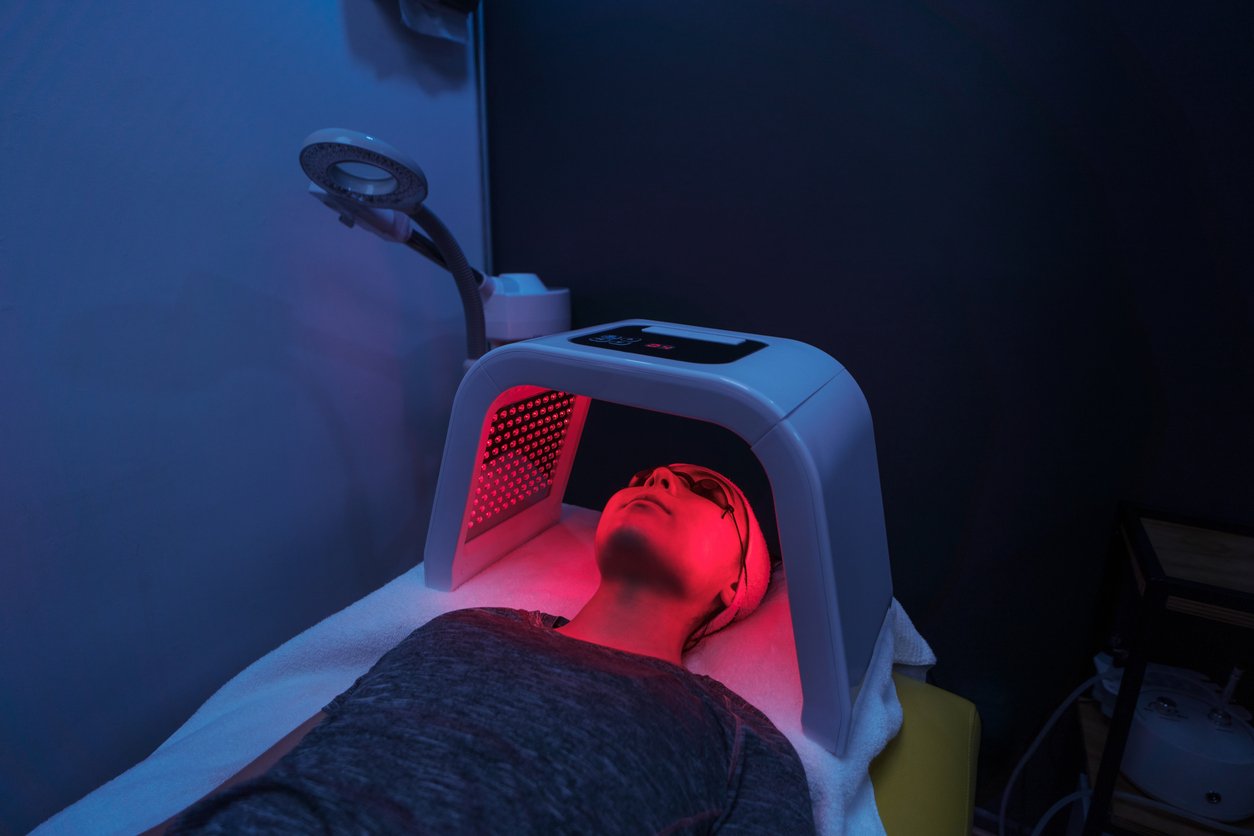
Red light therapy is also known as red light photobiomodulation (that sounds pretty scientifically legit, right?), low-level laser light therapy (LLLT), cold laser, or light-emitting diode (LED) therapy. Different types of light therapy have existed since the late 1800s. A Danish scientist, Niels Ryberg Finsen, won the 1903 Nobel Prize for his discovery that light therapy could treat a nasty form of tuberculosis, lupus vulgaris, that infects the skin.
Sadly, Finsen, who himself suffered from the disease, died before he could travel to Sweden and accept the prize. While others continued his work, the use of light therapy was eventually replaced by antibiotics and largely faded out of memory.
That is, until 1967 when Hungarian scientist Endre Mester began experimenting with the newly invented laser. His form of photobiomodulation (PBM) works by penetrating through the skin and directly affecting cells. In particular, PBM interacts with mitochondria — the “power stations” of our cells.
The photons of laser light can interact with the atoms and molecules of our cells, leading to biological alterations. That works because a light-sensitive enzyme, cytochrome c oxidase, is found in mitochondria. When that enzyme is activated, it enhances the mitochondria’s efficiency in producing adenosine triphosphate (ATP, the “fuel” that our cells use as energy).
Increased ATP levels mean that cells have more energy. They can use that extra power to promote faster and more effective healing, reduce inflammation, and boost overall cell function.
Light treatments are noninvasive and nonthermal — meaning they don’t involve inserting anything into the body or using heat. Instead, they act by triggering photochemical reactions.
Red Light vs. Near-Infrared Light
Photobiomodulation uses wavelengths in the red (600–700 nanometers, or nm for short) or near-infrared (NIR, 770–1200 nm) spectrum. They have different effects and use cases. Some treatments use just one or the other, and others deploy both.
Red light has a shallower penetration compared to NIR light, reaching about 2–3 mm below the skin. It’s most effective for surface-level treatments. By contrast, near-infrared light can penetrate much deeper into tissue, up to 5 cm or more. That makes it more suitable for treating deeper tissues, like muscles, tendons, and bones.
What Are the Benefits of Red Light Therapy?
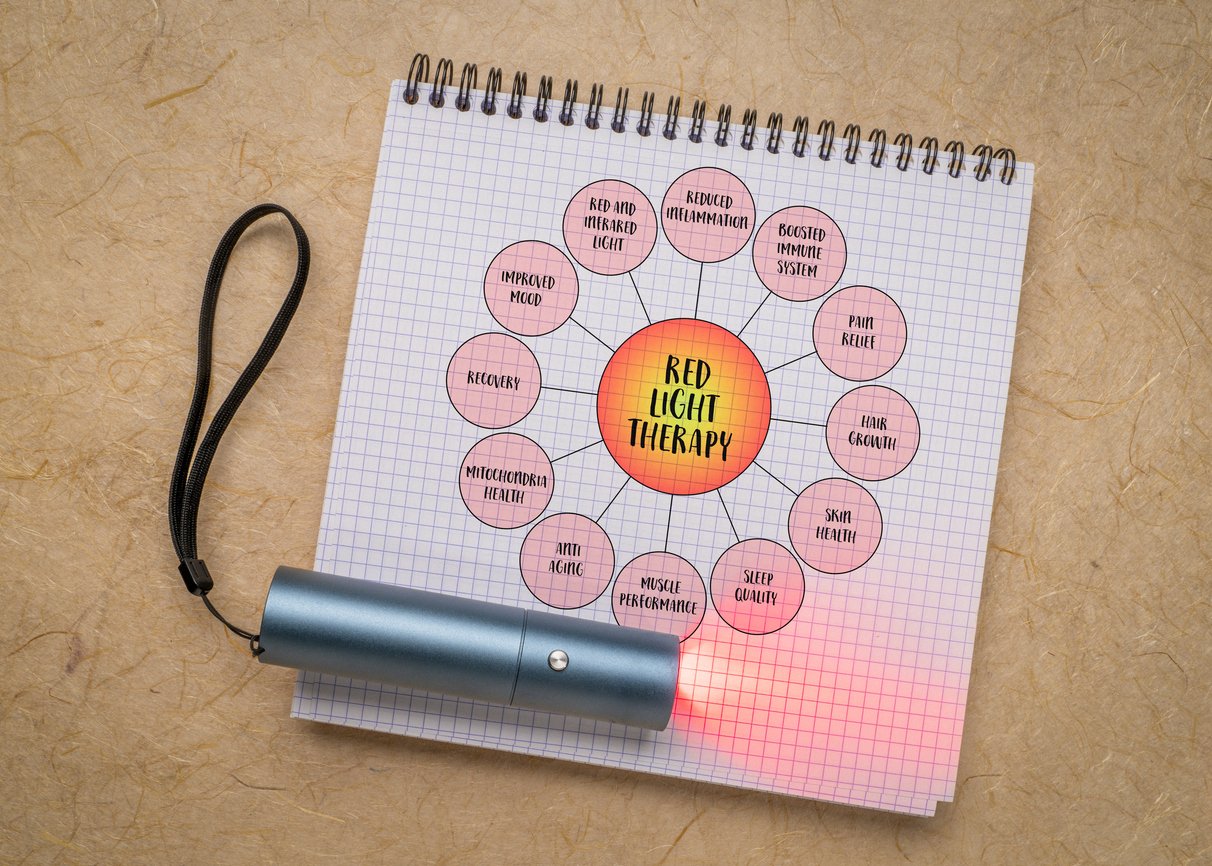
There are hundreds of studies of PBM, but many of them are considered “preliminary,” focusing on the effects on human cells in test tubes or animals. That’s done when scientists want to assess the safety of a novel treatment before testing it on humans to see if it works.
However, dozens of fascinating studies have also been conducted on the effectiveness of various forms of RLT in humans. And that, for the most part, is where we will focus in this article. Some studies examine treatments with low-dose lasers, while others look at LED light therapy. At the moment, laser treatments are not readily available for home use because of safety concerns over use errors.
(I’m picturing someone wielding a laser pointer like a lightsaber, accidentally zapping the cat instead of their sore shoulder!)
Red Light Therapy Skin Benefits
The beauty industry has touted the benefits of red light therapy for the look and feel of skin — specifically, its potential to smooth out wrinkles.
A 2007 study recruited 76 people, all of whom had noticeable facial wrinkling. The participants received two light treatments a week for four weeks: red near-infrared LEDs or sham light placebo treatments. Compared to the placebo group, the people receiving the red light treatments reduced wrinkles by up to 36%. And their skin became 19% more elastic, thanks to increased collagen and elastic fibers, which help keep skin firm and smooth.
A 2014 study explored the effects of LED PBM treatments of different wavelengths to improve skin appearance and feel and found similar positive results. Volunteers who received the treatments showed significantly improved skin complexion, feeling, roughness, and collagen density compared to controls.
Red Light Therapy for Pain
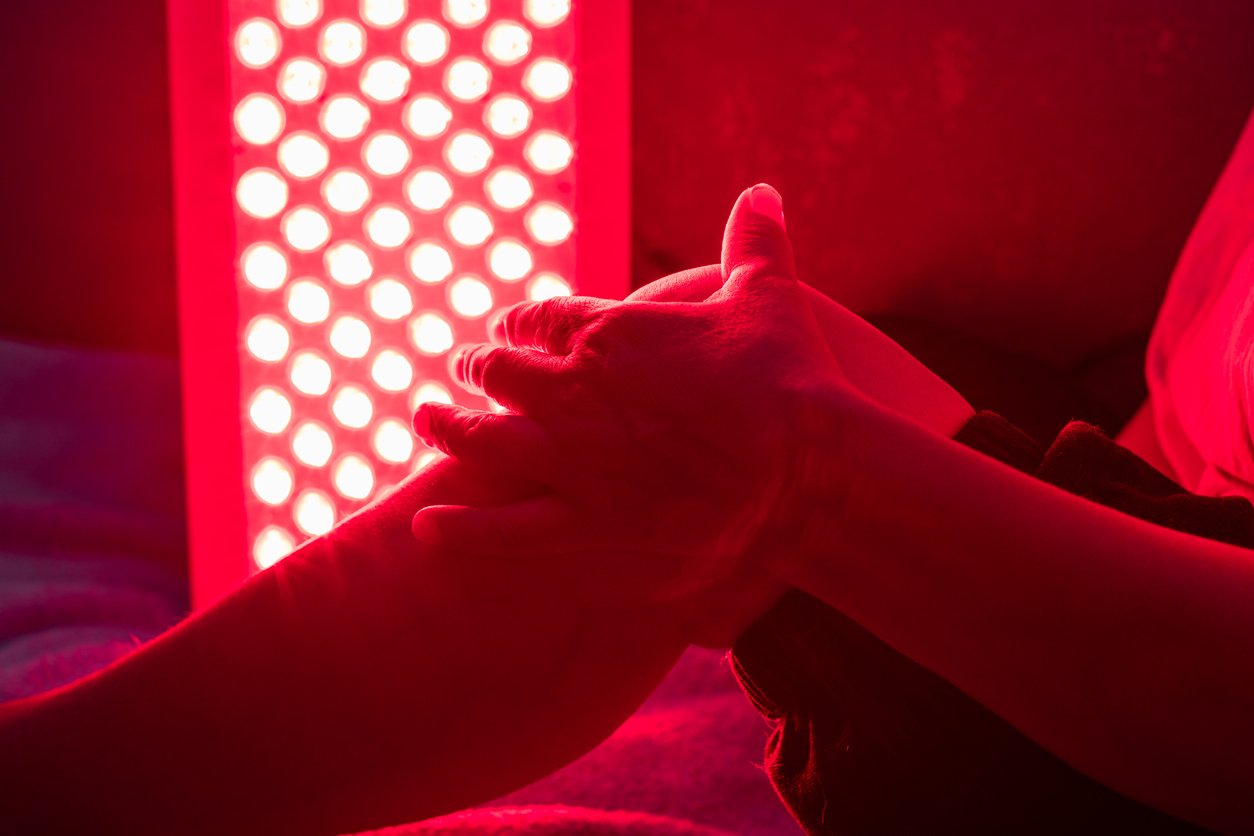
One early study explored how low-power light therapy could help older adults with knee pain from osteoarthritis. Researchers divided 50 participants into three groups, each receiving treatment with either red light, infrared light, or a placebo (a machine that looked like the light emitters but didn’t do anything). The participants used the lights on their knees for 15 minutes twice a day for ten days.
The red and infrared light groups experienced more than a 50% reduction in pain, while the placebo group saw little change. And the people treated with red and infrared lights showed improved mobility. Even more exciting, the red and infrared participants went several months without needing further treatment.
A 2017 study looked at ways to help women with painful menstrual periods. Researchers tested a belt that radiates near-infrared LED light on the stomach. Women who wore this belt had less pain, shorter pain duration, and used less pain medicine than those who used hot packs.
In 2022, researchers explored whether LED RLT could reduce shoulder pain caused by rotator cuff tendinopathy. They tested both infrared light, which penetrates deeper into tissues, and visible red light, which is absorbed closer to the surface (both are standard forms of red light therapy and not placebo treatments). The participants, all aged 45–70, had three sessions a week for four weeks and were evaluated on pain levels, shoulder movement, muscle strength, and overall quality of life.
The researchers found that each treatment was effective, with infrared light having a slight edge.
Red Light’s Effect on Mood
Could PBM help people with major depressive disorder by boosting brain function, lifting mood, and cutting down on stress and inflammation? In a 2018 study, participants received near-infrared LED light therapy on their heads twice a week for eight weeks, a protocol known as t-PBM (the “t” stands for transcranial, which you’re unlikely to hear on Sesame Street). On average, they showed a medium to large improvement in symptoms. And unlike pharmacological antidepressants, t-PBM wasn’t associated with any serious side effects.
A 2024 meta-analysis looked at lots of studies on PBM and depression. It found that PBM can reduce symptoms of depression. Interestingly, systemic PBM (s-PBM), in which PBM is applied to other body areas, such as the back, thighs, neck, or acupuncture points, was found to be effective in easing depressive symptoms in people who had lower back pain or were addicted to alcohol. Both laser and LED light showed promise in helping people cope with depression.
Red Light Therapy for Muscle and Exercise Recovery
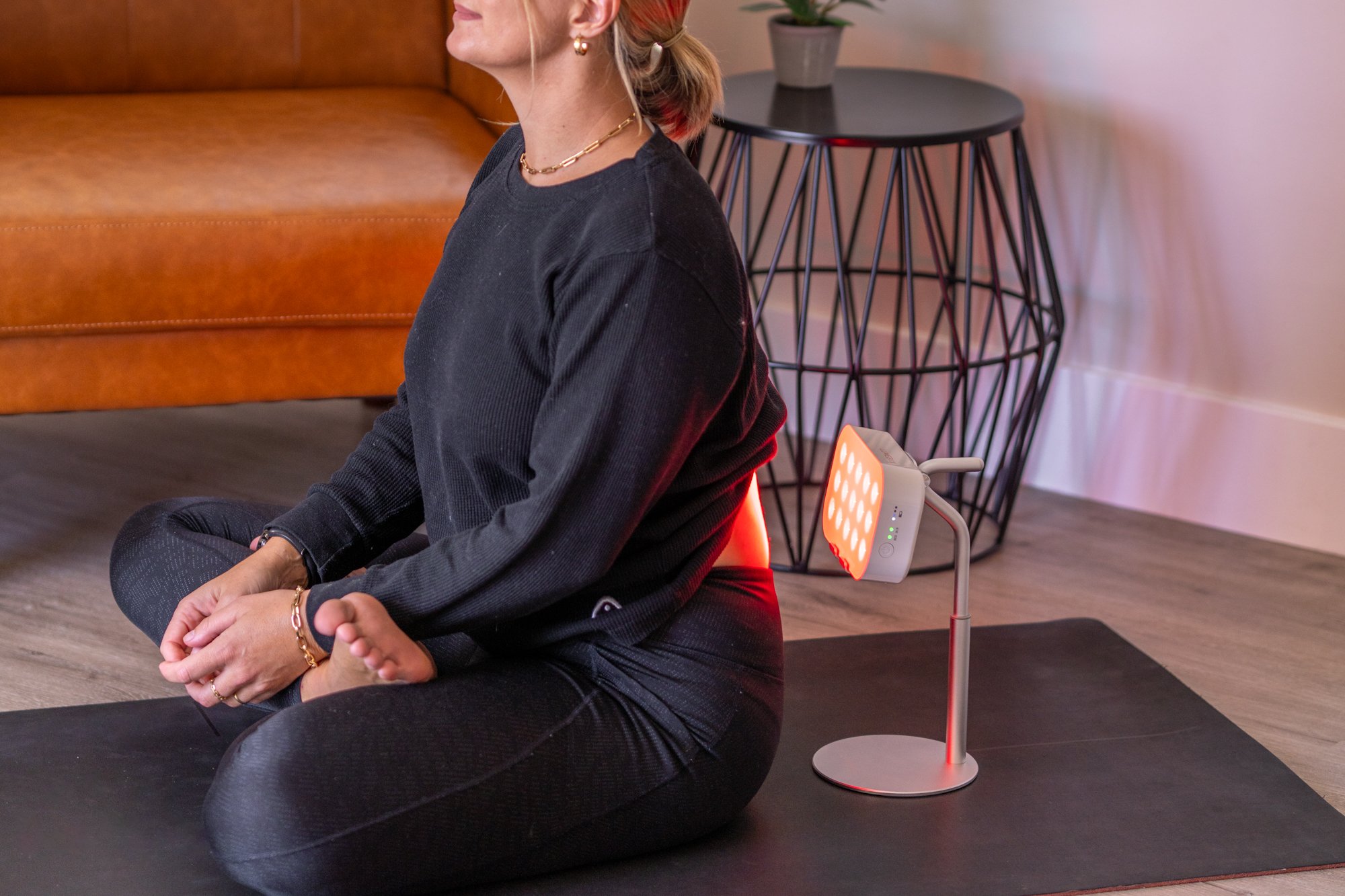
Wouldn’t it be exciting if you could point a light at your aching joints and muscles and get relief? Well, there’s some compelling evidence from studies focused on high-level athletes that RLT might be able to help.
In a 2009 study, researchers investigated a special kind of light therapy, cluster multi-diode light emitting diode therapy (thanks to the wonder of acronyms, we can call it LEDT). The researchers focused on ten male professional volleyball players. They found that the athletes could do 12.9% more bicep contractions and lasted 11.6% longer before getting tired when they received the LEDT treatment than when they got a fake treatment. Plus, after exercising, their blood showed lower lactate, creatine kinase, and C-reactive protein levels, which are markers of muscle fatigue and damage.
Then, a 2016 study explored how photobiomodulation therapy (PBMT) could help rugby players recover faster and perform better. The researchers wanted to see if using light from lasers and LEDs on the muscles before exercise could reduce fatigue and improve performance in real-life sports settings.
To test this, they conducted a study with 12 high-level rugby players. The players received either the actual PBMT treatment or a placebo. Those who received PBMT had better average sprint times and felt less tired than those who didn’t get the treatment.
A 2019 study replicated the 2016 study with 22 high-level male soccer players. After the treatments, the players did a challenging running test to see how far they could go before getting tired. The results were promising: The players who received active PBMT showed improved oxygen uptake, allowing them to run longer and harder compared to those who got the placebo. Additionally, they experienced less muscle damage and inflammation after the workout.
Red Light Therapy and Hair Growth
We know that light makes plants grow, but how about human hair?
A 2018 study looked into whether low-level light therapy (LLLT) can help people with androgenetic alopecia (a fancy name for male-pattern baldness, although it can also affect women). Researchers conducted a 24-week trial with 100 participants assigned to receive LLLT on one side of their head and a sham treatment on the other three times a week for 30 minutes each session.
After 24 weeks, the side treated with LLLT showed significantly more hair coverage (14.2% compared to 11.8% on the placebo side). I think it’s pretty fascinating that a placebo treatment could grow that much hair — although it also seems possible that it benefited from treatment on the LLLT side since, as far as I know, both sides of the scalp were connected. There were also improvements in hair thickness and count.
A 2024 study tested 650-nm LED red light therapy to treat androgenetic alopecia. Researchers conducted experiments using human hair follicles taken from patients undergoing hair transplants. They cultured these follicles and treated them with 650 nm red light, measuring the length of the hair and noting changes in cell activity and gene expression.
Red light therapy increased hair shaft length and delayed processes linked to hair loss. It promoted cell proliferation and activated several important biological pathways related to immune response, breaking down amino acids, and cell recycling and metabolism.
Red Light’s Immune System Effect
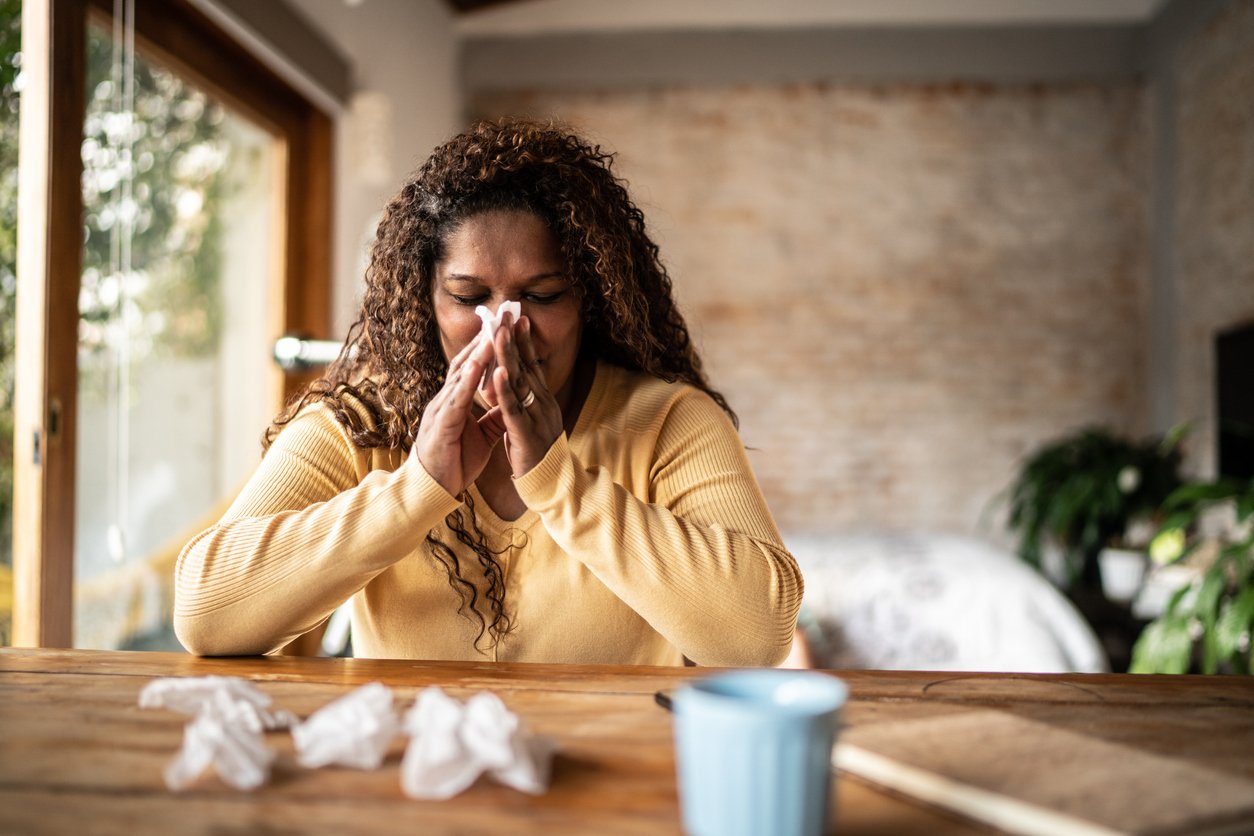
Red light therapy may also help boost the immune system. A 2021 meta-analysis examined evidence that low-level laser PBMT could help treat COVID-19 patients by boosting their immune system and reducing inflammation. Studies showed PBMT helped patients breathe better, reduced their markers of inflammation, and even prevented complications like thrombosis (blood clots).
A 2023 study explored the effects of PBMT on inflammation in mice. (Our view on the use of animals in medical research is here.) The researchers wanted to see if red and near-infrared light treatment for 30 minutes daily over 10 days could help reduce inflammation.
The results showed that PBMT significantly reduced levels of pro-inflammatory cytokines and increased an anti-inflammatory cytokine. This suggests that PBMT could be a promising therapy for managing inflammation in the body and potentially protecting against neurodegenerative disorders.
How to Use Red Light Therapy
Many protocols and types of red light therapy have been shown to help relieve and improve different conditions. It can also be used almost anywhere on the body; some protocols target the light (for example, only on the face or the cranium), while others shine the light on wide areas of the body.
The number of sessions you’ll need depends on the condition you want to treat.
For general skin health (keeping skin firm and minimizing wrinkles), a general recommendation is 2–3 sessions per week for 4–8 weeks. Session times vary, but the average length used in studies is around 20 minutes. At-home devices and professional treatments may have more specific recommendations.
For pain relief or muscle recovery, you may want to increase the frequency of treatments to 3–5 sessions per week.
Regarding the best red light therapy dose, there is no one-size-fits-all. Some people may see a benefit with very low light dosages, while others will get better results with big doses. The differences may be due to genetics and individual variations in mitochondrial function. So, just like we won’t all tan the same if we go out in the sunlight, we also may respond differently to red and near-infrared light.
It’s important to follow instructions for the device if you’re using an at-home treatment; professional treatments are done under the supervision of a technician who can guide you on dosage and frequency of treatment.
Professional Treatment
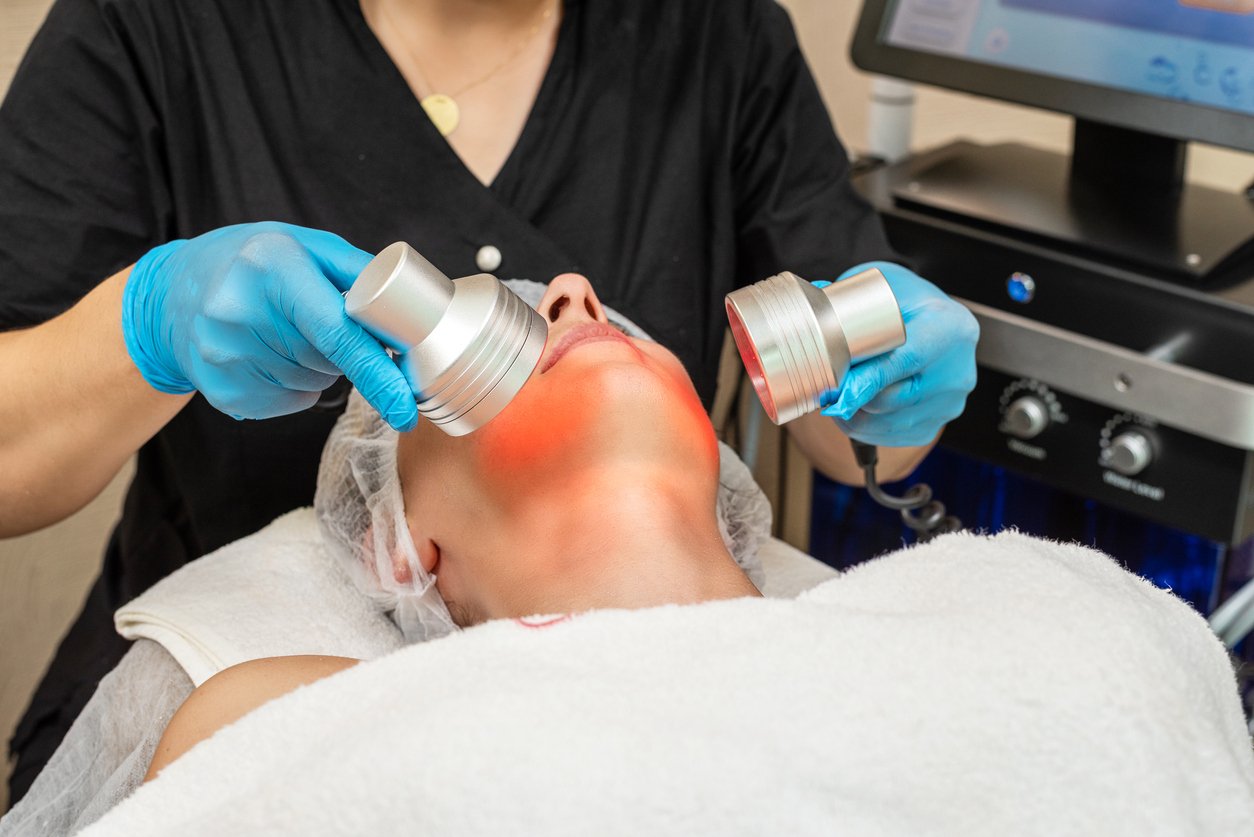
Professional red light therapy uses higher-powered devices and is more precise in treating specific conditions. It’s sometimes offered at dermatology clinics, med spas, physical therapy centers, and wellness clinics.
Unfortunately, Medicare and most insurance policies do not cover red light therapy, and multiple in-office treatments can be costly. That’s why many people are looking into purchasing at-home RLT units.
At-Home Devices
One downside of at-home red light therapy devices is the high upfront cost. However, when you consider the total cost of treatments, owning your device could be far more cost-effective than multiple treatments at a spa or medical center.
For best results, you may want to choose devices that have been cleared by the US Food and Drug Administration (FDA) or by the equivalent regulatory body in your country. This clearance indicates that the device has been tested to be both safe and effective.
There are three main categories of red light therapy devices:
- LED panels
- Face masks
- Handheld units
1. LED Red Light Therapy Panels
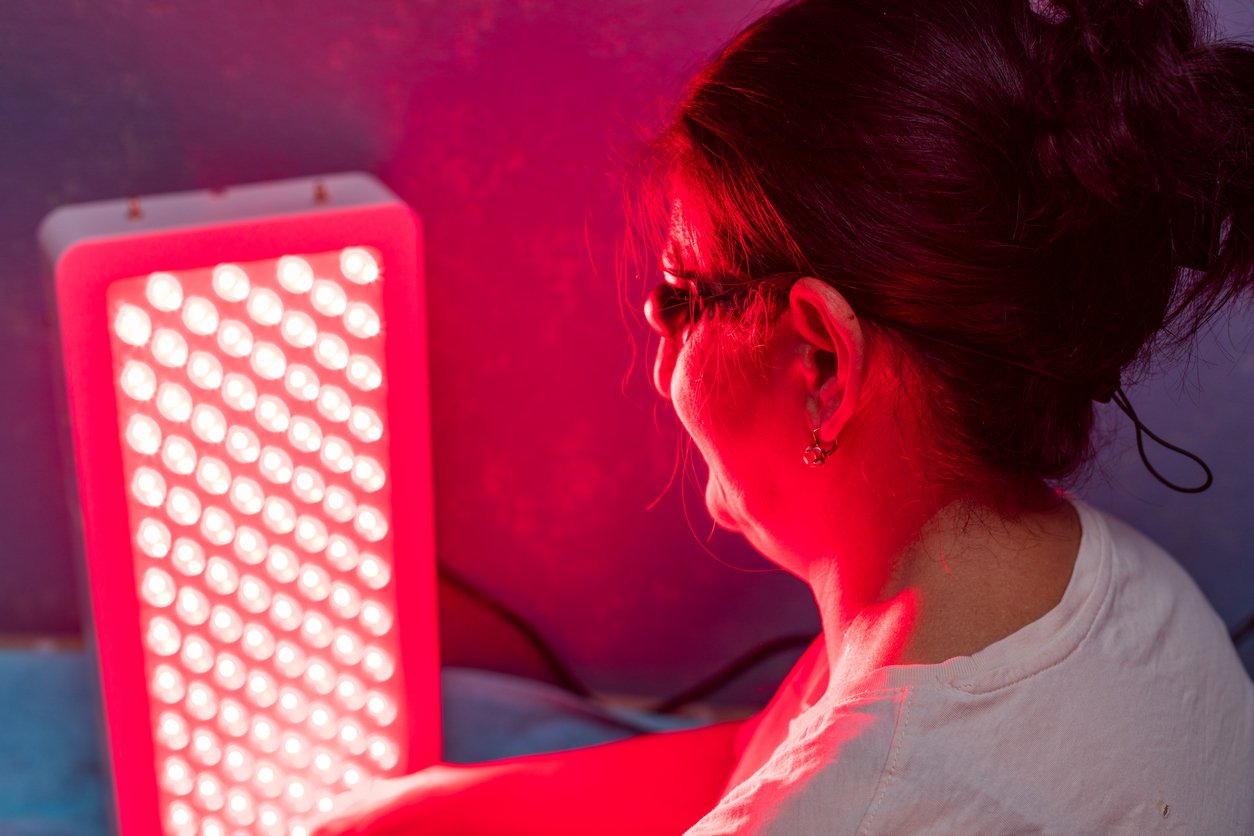
LED panels are designed to cover larger areas of the body, such as the back or legs (and sometimes, the entire body). Panels generally have a higher irradiance (a word I’ve just learned, which means light power output), meaning they can deliver a more powerful treatment in a shorter period.
Users typically sit or lie in front of or under the panel for a hands-free treatment.
LED panels are best for muscle recovery, full-body treatments, skin conditions across larger areas, and pain relief for broader regions.
2. Light Therapy Face Masks
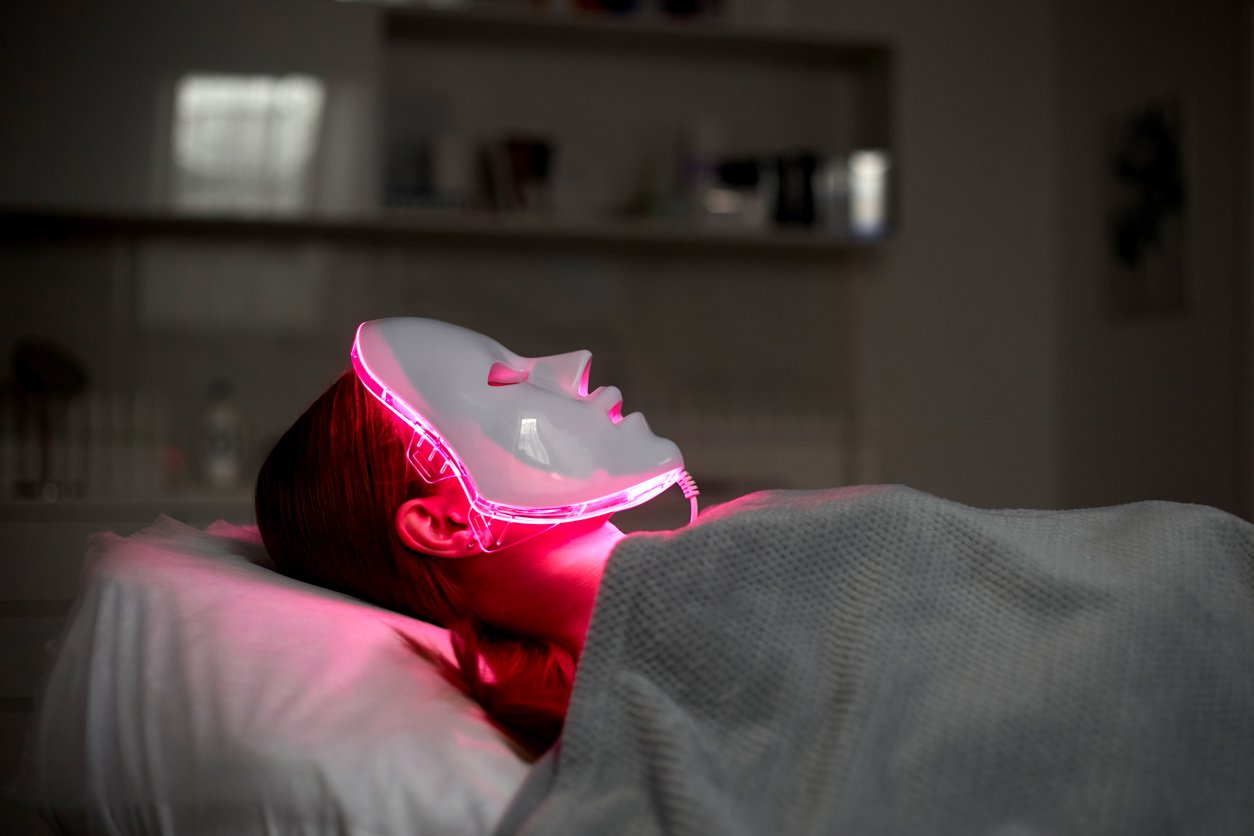
Red light therapy face masks target skin health issues on the face. They typically come as wearable devices, often fitting comfortably over the face. Compared to LED panels, they use much less power. They’re best for skincare routines, improving skin appearance, reducing acne, wrinkles, and other signs of aging.
3. Handheld Red Light Therapy Units
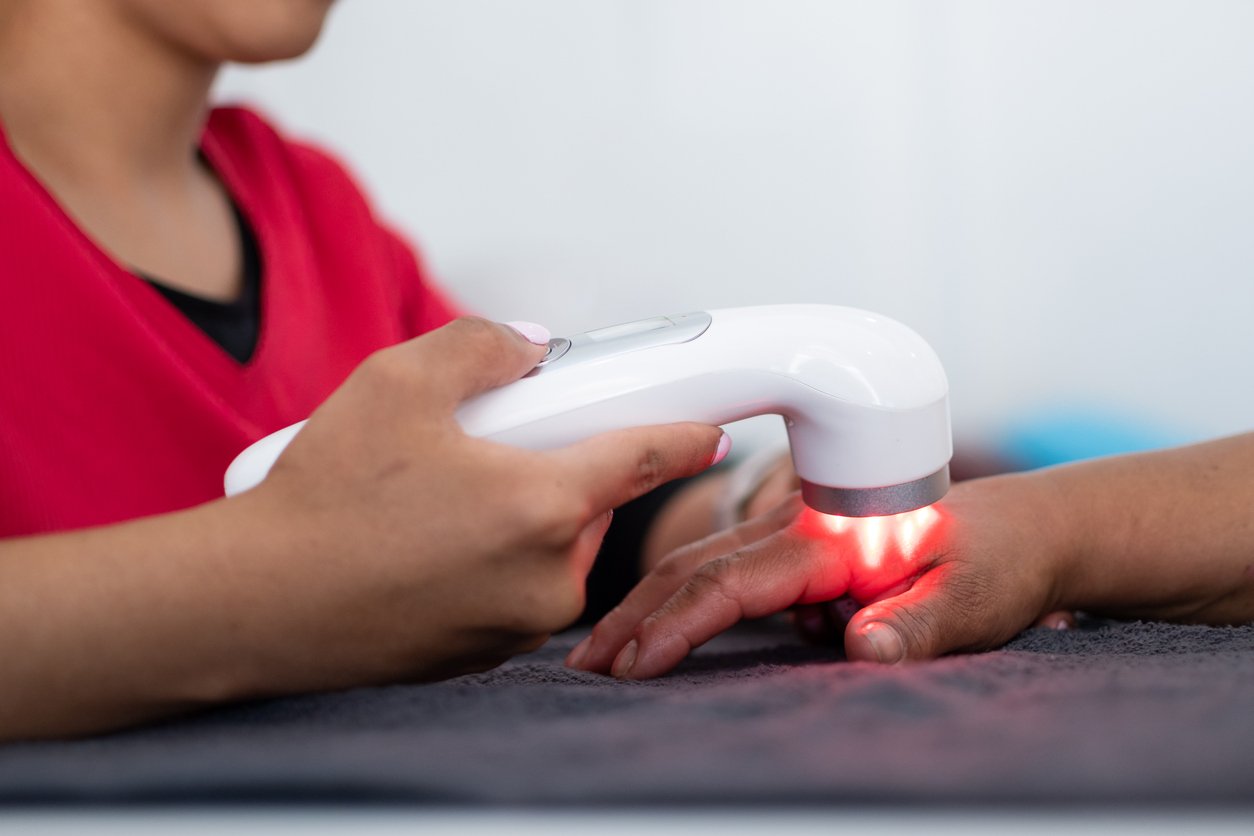
Smaller, portable handheld units, such as wands or boxes, are designed for targeted treatment of specific areas. They’re highly flexible because you can direct them exactly where needed. You hold the device directly on or near the treatment area for a set duration, allowing for more precise and concentrated sessions.
Handheld RLT units are best for treating localized areas such as joints, small patches of skin, and specific muscle pains; due to their portability, they are also great for travel.
Side Effects and Precautions of Using Red Light Devices
While RLT treatments are quite safe in research studies (a good deal safer, in terms of side effects, than pharmaceuticals and surgery), there are some precautions you should observe to minimize any risk of harm.
First, do not stare directly at the LEDs to avoid retinal damage. Always use eye protection when doing RLT with any device that reaches your eyes. If your eyes are sensitive to light or if you take medications that cause photosensitivity, consult a medical professional before use.
Keep the settings low or moderate on at-home red light therapy devices, and don’t overuse them. High settings at prolonged usage could cause blistering, redness, or hyperpigmentation, much like a sunburn. Follow the directions that accompany your at-home device, or use it under the supervision of a technician.
Finally, while there’s no reason to suspect any long-term negative effects of RLT, no studies have been conducted long enough to eliminate all doubt.
Give Red Light Therapy a Try!
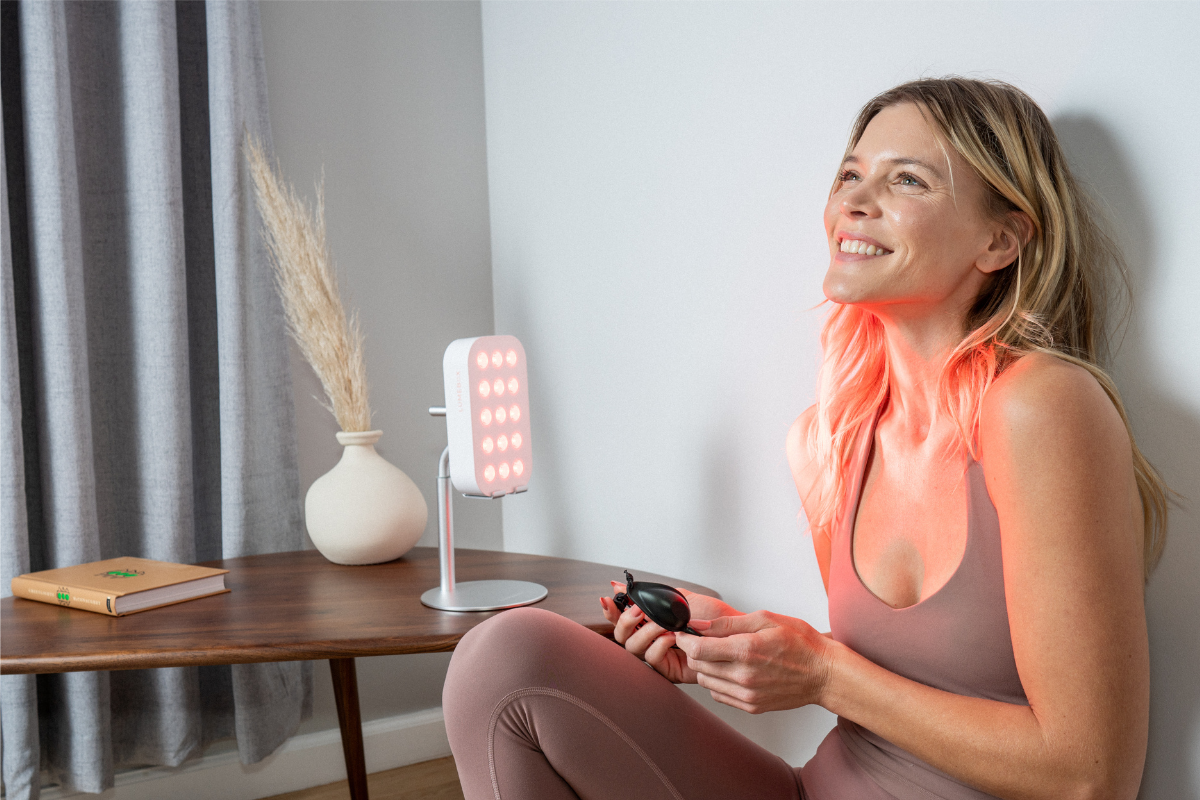
Whether you’re considering red light therapy for its skin benefits, pain relief, athletic performance, or general wellness, choosing the right device and following the recommended treatment guidelines is important. With a variety of at-home and in-person options, you can look for a solution tailored to your particular needs and goals. RLT could be a valuable resource for anyone interested in enhancing their health or beauty.
The LUMEBOX stands out as an FDA-registered red light therapy panel designed by a medical doctor with your health as the focus. It’s also third-party tested for high irradiance and optimal wavelengths. Each bulb delivers red (660nm) and near-infrared (850nm) light, making it 80% more powerful than leading portable devices. In addition to its effectiveness, the LUMEBOX is built to meet the International Electrotechnical Commission’s strict standards for medical devices, which ensures low EMF levels and certified safety.
With its portability and long battery life, the LUMEBOX is versatile enough to support everything from skin rejuvenation to joint health, eliminating the need for multiple red light systems. Typically, a device of this quality would cost over $600, but for a limited time, you can get the LUMEBOX at a special discount for FRN members here. As an added bonus, the LUMEBOX is FSA/HSA-eligible in the U.S., enabling you to use pre-tax dollars. Simply select Truemed as the payment option at checkout.
If you purchase through that link, LUMEBOX will contribute a portion of the proceeds to support Food Revolution Network’s mission. (Thank you!)
Tell us in the comments:
- Have you ever heard of red light therapy?
- Now that you know what red light therapy is and its potential benefits, will you try it?



